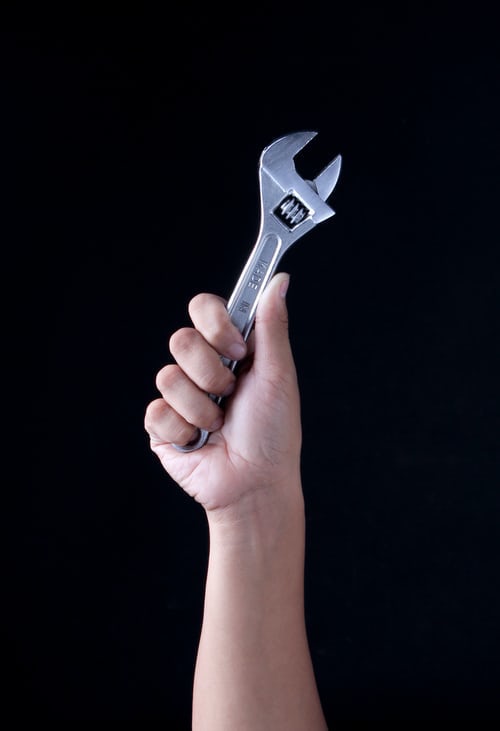
The trend in recent years in electronics is to use soldered systems instead of replaceable individual components. Image courtesy of Sahand Babali for Unsplash. Free to use under Unsplash license.
Latest News
October 26, 2021
The famous hamburger chain McDonald’s has been in the news recently for a problem that serves as an example of a bigger issue gaining attention—the right to repair.
The digital soft serve ice cream machines in more than 18,800 McDonald’s are manufactured by Taylor Company. They cost $18,000 each, and are famously high maintenance. McDonald’s official Twitter account once acknowledged how often the machines have to be taken out of service for repair: “We have a joke about our soft serve machines but we’re worried it won’t work.”
These complicated machines dispense soft serve and milkshakes at the same time. They have to be completely disassembled for cleaning every two weeks. If something goes wrong, the sales contract specifies only a Taylor-approved technician can do the work.
A company called Kytch released a diagnostic device and repair kit for the Taylor machines in 2019, so independent franchises could do the repair work themselves. Taylor warned franchises using Kytch products to service the soft serve machines could cause “serious human injury.”
Kytch has responded with a lawsuit, disputing the possibility of injury and claiming McDonald’s gave Taylor a “virtual monopoly” on repair and service, worth $80 million in 2017.
The suit is ongoing, and is one skirmish in a larger battle taking place over the concept of consumers having the right to repair products they purchase, as they see fit.
Voiding the Warranty?
“There is a common perception that if you disassemble the product you void the warranty,” says Kyle Wiens, CEO of iFixit, a company that specializes in providing information on how to repair products. “It is illegal to void the warranty if you disassemble; it is fraud to claim otherwise.”
Designers need to understand this, Wiens says, “and they need to design accordingly.”
The right to repair was also an issue in a recent executive order from U.S. President Joe Biden. As part of a sweeping review of relevant supply chains—and how they failed during the pandemic—the U.S. government is looking for various ways to strengthen the product pipeline. The review comes after the U.S. Federal Trade Commission (FTC) issued a 55-page report to Congress that noted, “there is scant evidence to support manufacturers’ justifications for repair restrictions.”
In discussing this directive, the White House noted there would be a separate executive order to address widespread complaints from farmers that they are prevented by manufacturers from repairing their own equipment.
Repairability Index
France recently introduced a Repairability Index, which requires manufacturers to display a rating if a product is repairable, difficult to repair or not repairable at all. The regulation is being phased in, starting with front-loading washing machines, televisions, smartphones, laptop computers and electric lawnmowers. The French government sees this as the first step in a more comprehensive sustainability index.
Wiens and others involved in the right to repair discussion see the Index as more than a customer convenience issue. “We need 10- to 20-year life spans for everything, and [need to] stop designing products to only last a year or two,” says Wiens. He cites wireless in-ear headphones with glued batteries as a prime example. “They last two years, then the product has to be disposed of.”
Sustainability and Repair Rights
Zoé Bezpalko is sustainability strategy manager for Autodesk. Her mandate is to lead communications and research in sustainability for manufacturing. “We see design for repair as a sustainability integrated topic,” she says. Making a product last longer by exercising the right to repair is part of a bigger discussion on “circularity and the circular economy.”
“Customer frustration is huge,” Bezpalko continues. “Repair is better for the environment.” She notes three points about the importance of design for repair:
- Products must be designed with repairability in mind.
- Spare parts must be available to consumers and the aftermarket repair industry.
- Repair documentation must be readily available.
There is a perception that sustainability is the responsibility of the consumer, adds Paul Sohi, Autodesk product marketing manager for additive manufacturing. “The consumer’s impact is next to zero. The majority of engineers, for whatever reason, are not thinking about environmental impact.”
“It is easy to say ‘stop using glue’ in manufacturing smartphones,” Sohi says, but such isolated thinking does not address the results in time to market, profitability and the whole conversation about repairability and its relationship to sustainability.

Having accessible parts for repair also speaks to the issue of supply chain resilience, notes Bezpalko. If spare parts must be available for 10 years, it may be wasteful to fill the product pipeline with parts that just sit on the shelf. If these same parts could be designed for on-demand 3D printing, it would eliminate the need for stockpiles.
Model-based Engineering
Updating product engineering workflow to model-based systems engineering (MBSE) is one way to address all the challenges related to design for repair, says Scott Collins, CTO at Anark. Anark makes software for industrial technical content publishing and visual collaboration.
“Design engineers generally have a narrow focus,” Collins says. MBSE allows “multiple stakeholders in the overall system to be represented, down to maintenance/repair level.”
From Anark’s perspective, to facilitate design for repair and other sustainability issues requires connecting a digital thread from design engineering to various and traditionally isolated silos in the extended enterprise content.
“Think of design/engineering as the headwaters, then content flows down to manufacturing and contract suppliers, then down to in-house manufacturing, then field service,” says Collins.
“Those who solve supply chain issues best are the ones who have everyone involved. It is too easy for design and engineering to work in a box,” Collins says. “Manufacturing engineers and field service teams also need a voice into design.”
He echoes the call for bringing digital thread and digital twin technology into the workflow and notes that engineers are not trained in collaborative, systems-based processes.
Change Minds First
Some industries have more traditionally been about repairability, says Stephen Jorgenson-Murray, a SIMULIA global marketing specialist at Dassault Systèmes.
“Farming has changed, it used to be all about easy repair.” Factory machines are another example. “Now the right to repair [movement] wants other industries to come along.”
Jorgenson-Murray thinks the transition can be fast, if companies adopt forward-thinking workflows like MBSE. “MBSE helps companies design for repair by showing how everything connects.”
Engineering teams don’t necessarily need new software if they change their mindset about repairability and sustainability.
“There are many older generation engineers who have a 1990s repairability ethic, perhaps this is what the 2020s need,” Jorgenson-Murray says.
Consumer Attitudes
Samsung recently commissioned a survey of French consumers to study how the new Repairability Index has influenced consumer behavior. Findings include:
- A whopping 83% say they try to repair or have repaired their faulty devices instead of replacing them immediately.
- Only 29% leave the repair to a professional service.
- A notable 71% of the French have heard about the index.
- Significantly, 80% of those age 50 or older know about the Index, while only 52% of those ages 18-25 have heard about it.
- A total of 86% say the Index impacts their purchasing behavior.
- Lastly, 80% would give up their favorite brand for a more repairable product.
“People just want to fix stuff,” comments iFixit’s Wiens. “Repairability is more important to manufacturing than sustainability issues; it is the real imperative driving behavior of consumers.”
Randall S. Newton is principal analyst at Consilia Vektor, covering engineering technology. He has been part of the computer graphics industry in a variety of roles since 1985. Contact him at [email protected].
More Autodesk Coverage
Subscribe to our FREE magazine, FREE email newsletters or both!
Latest News
About the Author
Randall S. Newton is principal analyst at Consilia Vektor, covering engineering technology. He has been part of the computer graphics industry in a variety of roles since 1985.
Follow DE






